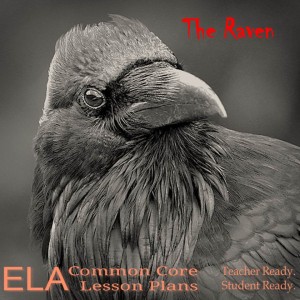My colleague just told me that April was National Poetry month. I thought she was playing an April Fool’s joke on me, so I took a swing at her. She blocked the punch, jabbed me in the throat with a paper clip, whacked me on the head with a stapler, and knocked me out.
When I awoke there was a dead crow stapled to my forehead with some great lesson plans for “The Raven.”
Turns out it is National Poetry Month and a good day for “Raven” lesson plans.
In honor of National Poetry Month, here is a great symbolism lesson plan for “The Raven” by Edgar Allan Poe. Use this symbolism in “The Raven” chart. I made it myself.
Symbolism in “The Raven” Lesson Plan

This teaching guide for “The Raven” includes lesson plans, graphic organizers with answer keys, a summary, analysis, a quiz with answer keys, an essay rubric, and more.
We’ll start with those pesky objectives that your administrator thinks are so precious. We’ll word them in educatorese here. It’s good to have them handy so you can focus the lesson where it needs to go. If you’re going to write an objective on the board (sound teaching practice), pick one or more of these standards and reword it so students know what the heck they should be focused on. Here’s what you might write.
Find specific examples of symbolism in “The Raven,” explain the symbol, and analyze its effect on the overall theme, or meaning, of the story.
It takes a teacher to say in 25 words what it takes a lawyer, a politician, and a college professor sitting in their theory rooms to come up with in however many words are contained in the following standards:
- RL 9-10.1 Cite strong and thorough textual evidence to support analysis of what the text says explicitly as well as inferences drawn from the text.
- RL 9-10.2 Determine a theme or central idea of a text and analyze in detail its development over the course of the text, including how it emerges and is shaped and refined by specific details; provide an objective summary of the text.
- RL 9-10.4 Determine the meaning of words and phrases as they are used in the text, including figurative and connotative meanings; analyze the cumulative impact of specific word choices on meaning and tone (e.g., how the language evokes a sense of time and place; how it sets a formal or informal tone).
- RL 11-12.3 Analyze the impact of the author’s choices regarding how to develop and relate elements of a story or drama (e.g., where a story is set, how the action is ordered, how the characters are introduced and developed).
Procedures
- Discuss symbolism
- Hand out “The Raven” Symbolism Chart. If you look at it before you hand it out, you’ll know exactly what to do. It’s self-explanatory.
- Sit back and accept the applause from an admiring student body.
Symbols in “The Raven”

Imagine having 11 complete poetry units with handouts and lesson plans completed. You don’t need to imagine. These units are teacher ready and student ready. Just print, make copies, and accept accolades from colleagues and students.
Lenore: The narrator gives no description of Lenore. We do not know what she looks like or what exactly the relationship between Lenore and the narrator is. All we know is that the narrator really misses her. The lack of details regarding Lenore makes her a likely symbol. She may represent idealized love, beauty, truth, or hope in a better world. She is “rare and radiant” we are told several times, an angelic description, perhaps symbolic of heaven. Lenore may symbolize truth: the narrator cannot help but think of her, and her ubiquitous, yet elusive, nature haunts the narrative.
The Raven: The most obvious symbol is contained in the poem’s title. The raven enters the room imperiously and holds dominion over the narrator. The bird’s darkness symbolizes death; hence, death becomes a constant reminder, an imperious intruder. If taken in a broader context, the poem may be about the inability of man to escape his ultimate fate, a reoccurring theme in Poe’s short works.
Night’s Plutonian Shore: The phrase “Night’s Plutonian Shore” incorporates all the negative aspects associated with death. Pluto is the Roman god of the underworld; hence, his shore would be the underworld. Combined with “night,” a common symbol for death and nothingness, and shore, representative of the vast ocean and all its mysterious inhabitants, Plutonian takes on an enhanced meaning.
More Symbols in “The Raven”
Nepenthe: The narrator desperately searches for something that will remove his pain and suffering. This is symbolized by Nepenthe, an ancient drug used to help one relieve sorrows.
The Bust of Pallas: Pallas Athena was the Greek goddess of wisdom. It is upon this wisdom that the raven settles, adding credence, at least according to the narrator, to its utterances. The bust of Pallas and the raven’s subsequent perch on it may be ironic, for it is the narrator that gives the bird such wisdom. A casual observer would assume the bird sits there because it seems like a logical resting place. If you’re ever in Europe, note how the pigeons perch themselves on statues in the center of town. Only a moron would assume a bird takes on the character of a statue on which he perches. I don’t think, for example, that a bird resting on Napoleon’s shoulder suddenly becomes a ruthless general.
Midnight: Traditionally referred to as the witching hour and the darkest part of night–midnight is more than a number on the clock. It is no accident that Poe chooses this as the time for the bird’s arrival.
December: Nothing lives in the winter. December is in the winter. December symbolizes death.
Last Updated on March 12, 2018 by Trenton Lorcher
Share This:
Love your sense of humor. It was quite refreshing amid this world of standards and objectives to be able to crack a smile now and again. Also, thanks for the lesson plan. It was exactly what I was looking for.
Thanks Charles,
Glad I could help. That’s exactly why I created the site.